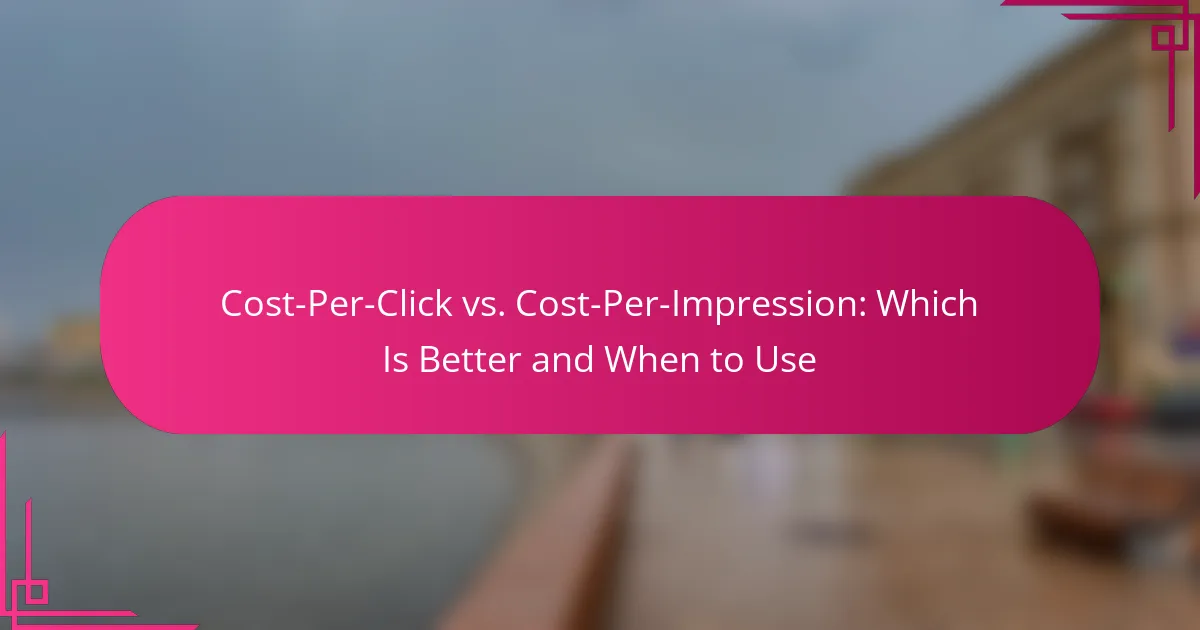Understanding the differences between Cost-Per-Click (CPC) and Cost-Per-Impression (CPI) is crucial for optimizing your advertising strategy. CPC focuses on driving traffic by charging advertisers only when users click on their ads, making it ideal for lead generation and sales campaigns. In contrast, CPI charges for ad displays regardless of clicks, which is beneficial for enhancing brand visibility and awareness. Choosing the right model depends on your specific marketing goals and desired outcomes.
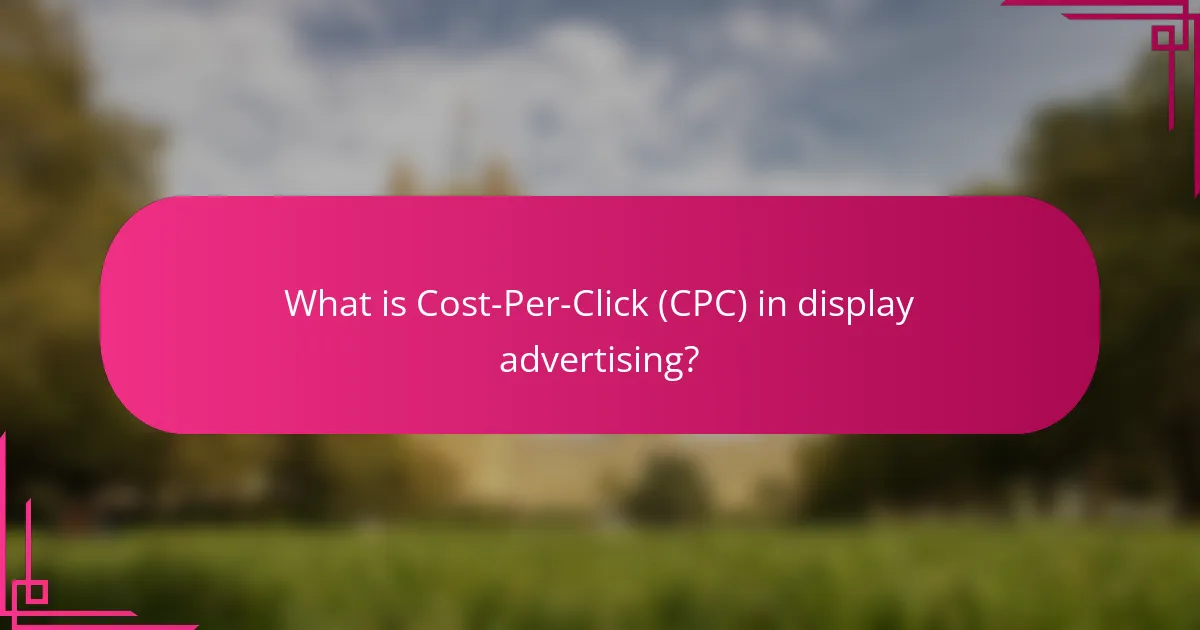
What is Cost-Per-Click (CPC) in display advertising?
Cost-Per-Click (CPC) is a pricing model in display advertising where advertisers pay each time a user clicks on their ad. This model focuses on driving traffic to a website, making it essential for campaigns aimed at generating leads or sales.
CPC definition
CPC refers to the amount an advertiser pays for each click on their ad. It is a common metric used to measure the effectiveness of online advertising campaigns. Advertisers set a maximum bid for how much they are willing to pay per click, which can vary based on competition and ad placement.
Benefits of CPC
The primary benefit of CPC is that advertisers only pay when a user takes action by clicking on their ad, making it a cost-effective option for driving targeted traffic. This model allows for better budget control, as costs are directly tied to user engagement.
Additionally, CPC campaigns can provide valuable insights into user behavior and ad performance, enabling advertisers to optimize their strategies. By analyzing click-through rates and conversion rates, marketers can refine their targeting and improve return on investment.
Common platforms using CPC
Several popular advertising platforms utilize the CPC model, including Google Ads and Facebook Ads. These platforms allow advertisers to set bids for specific keywords or audience segments, ensuring that their ads reach the right users.
Other platforms, such as LinkedIn and Twitter, also offer CPC options, making it versatile for various marketing goals. Each platform has its own bidding strategies and tools to help advertisers maximize their ad spend effectively.
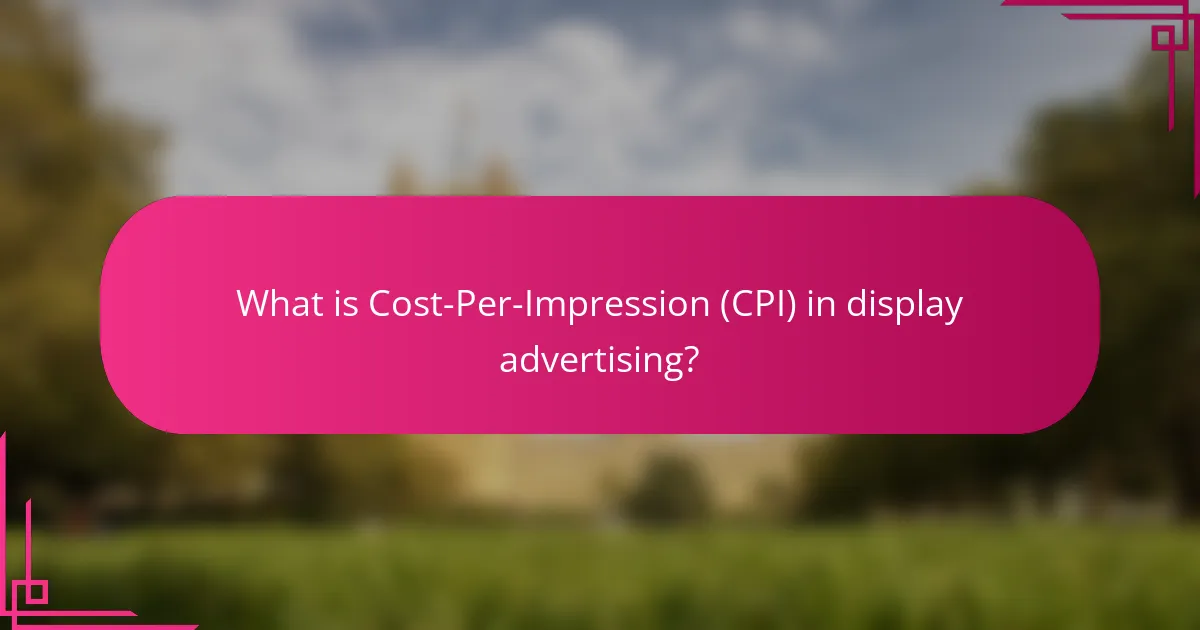
What is Cost-Per-Impression (CPI) in display advertising?
Cost-Per-Impression (CPI) is a pricing model in display advertising where advertisers pay for each time their ad is displayed, regardless of whether it is clicked. This model is often used to increase brand visibility and awareness among potential customers.
CPI definition
CPI refers to the cost incurred by an advertiser each time their ad is shown to a user. This metric is crucial for campaigns focused on brand exposure rather than immediate conversions. Advertisers typically calculate CPI by dividing the total cost of the ad campaign by the number of impressions served.
Benefits of CPI
One of the primary benefits of CPI is the ability to reach a broad audience, as it emphasizes visibility over direct engagement. This model is particularly effective for brand awareness campaigns, where the goal is to familiarize potential customers with a product or service. Additionally, CPI can lead to lower costs per impression compared to other models, making it budget-friendly for advertisers.
Another advantage is the straightforward tracking of impressions, allowing advertisers to gauge the reach of their campaigns easily. This can help in adjusting strategies based on audience engagement and visibility metrics.
Common platforms using CPI
Several popular advertising platforms utilize the CPI model, including Google Display Network, Facebook Ads, and programmatic advertising networks. These platforms allow advertisers to set specific targeting criteria to ensure their ads reach the desired audience effectively.
For instance, Google Display Network offers CPI options for advertisers looking to maximize exposure across various websites. Similarly, Facebook Ads provides CPI pricing for ads displayed in users’ feeds, enhancing brand visibility among targeted demographics.
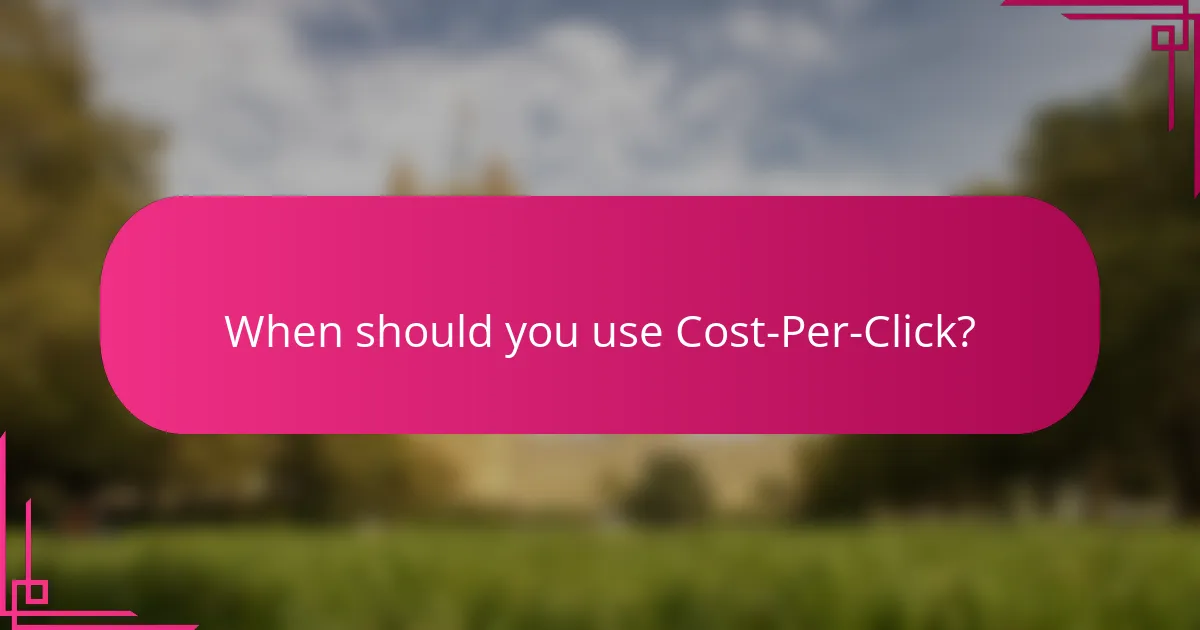
When should you use Cost-Per-Click?
Cost-Per-Click (CPC) is ideal when your primary goal is to drive traffic to your website and generate leads or sales. This model is effective for campaigns where you want to pay only when a user clicks on your ad, ensuring that your budget is spent on engaged users.
Best scenarios for CPC
CPC is best utilized in scenarios where direct response is crucial, such as e-commerce campaigns or lead generation. If your objective is to increase website visits or conversions, CPC allows you to focus on users who show intent by clicking on your ads.
Additionally, CPC works well for time-sensitive promotions or events, where immediate action is necessary. For instance, if you are launching a new product or running a limited-time offer, using CPC can help you reach potential customers quickly.
Target audience considerations for CPC
Understanding your target audience is essential when using CPC. If your audience is highly specific and likely to convert, CPC can be a cost-effective choice. For example, niche markets may respond better to targeted ads, leading to higher click-through rates.
Moreover, consider the platforms where your audience engages most. If they frequently use social media or search engines, CPC campaigns on these platforms can yield better results. Tailoring your ads to fit the preferences and behaviors of your audience will enhance the effectiveness of your CPC strategy.
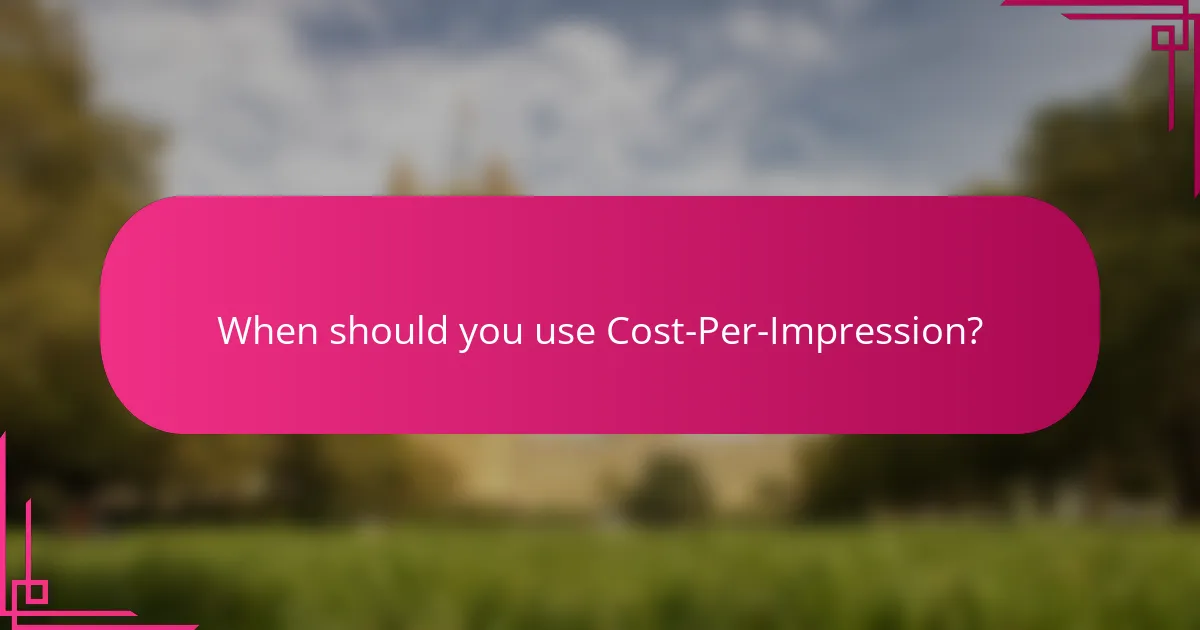
When should you use Cost-Per-Impression?
Cost-Per-Impression (CPI) is best used when brand visibility is a priority, rather than direct conversions. This model allows advertisers to pay for ad views, making it suitable for campaigns focused on awareness and reach.
Best scenarios for CPI
CPI is particularly effective for campaigns aimed at building brand recognition or launching new products. For instance, if a company is introducing a new beverage, using CPI can help ensure that the ad is seen by a large audience, even if immediate purchases are not the goal.
Additionally, CPI works well in industries where visual appeal is crucial, such as fashion or travel. Here, showcasing stunning visuals can attract attention and create interest, leading to future engagement.
Target audience considerations for CPI
When using CPI, understanding your target audience is essential. If your audience is broad and you want to maximize exposure, CPI can be advantageous. For example, a local restaurant might use CPI to reach all potential diners in a city, rather than focusing solely on those ready to order.
However, if your audience is niche and conversion-focused, consider whether CPI is the right fit. In such cases, a Cost-Per-Click (CPC) model might yield better results, as it targets users more likely to engage with the ad directly.
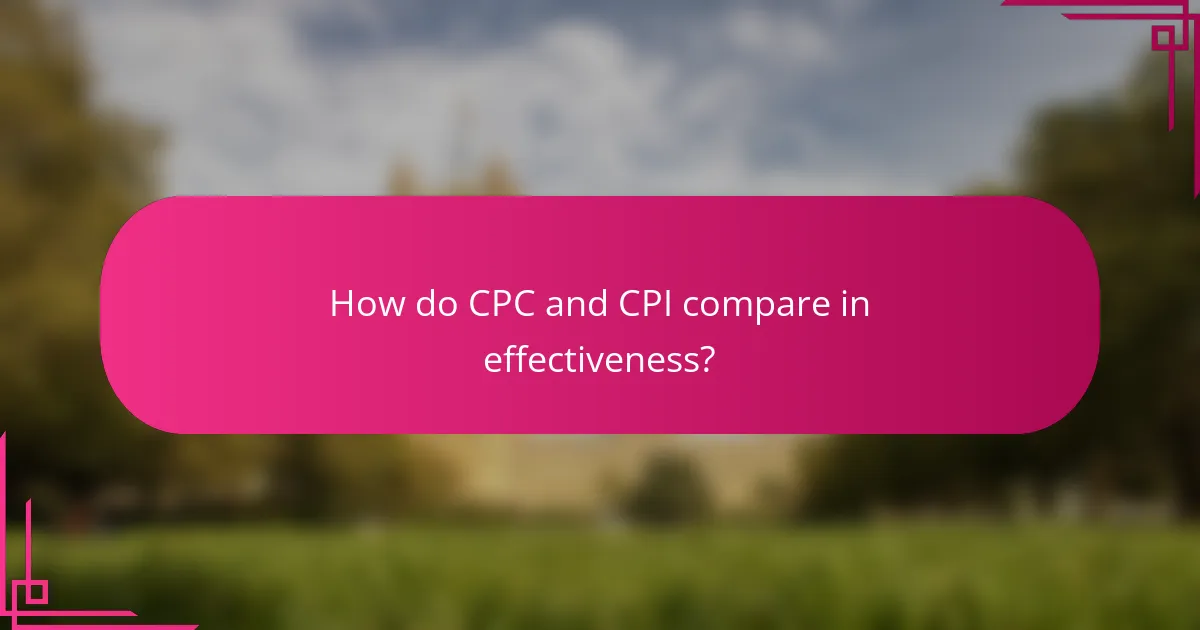
How do CPC and CPI compare in effectiveness?
CPC (Cost-Per-Click) and CPI (Cost-Per-Impression) are two distinct advertising models that serve different marketing goals. CPC focuses on driving traffic through clicks, while CPI emphasizes brand visibility through impressions, making each effective in different contexts.
Performance metrics comparison
When comparing performance metrics, CPC campaigns are often measured by click-through rates (CTR) and conversion rates, which indicate how effectively ads drive user actions. In contrast, CPI campaigns prioritize impressions and reach, assessing how many users view the ad regardless of interaction.
For instance, a CPC campaign may yield a high CTR but low conversions if the landing page is not optimized. Conversely, a CPI campaign might generate significant brand awareness but may not directly translate to immediate sales.
Cost efficiency analysis
Cost efficiency varies between CPC and CPI based on campaign objectives. CPC can be more cost-effective for direct response campaigns where immediate user action is desired, often resulting in lower costs per acquisition. Typical CPC rates can range from a few cents to several dollars depending on the industry and competition.
On the other hand, CPI can be advantageous for brand-building efforts, especially in markets where visibility is crucial. However, it may lead to higher costs without guaranteed engagement, as advertisers pay for impressions rather than clicks. Evaluating the specific goals of your campaign will help determine which model offers better cost efficiency.
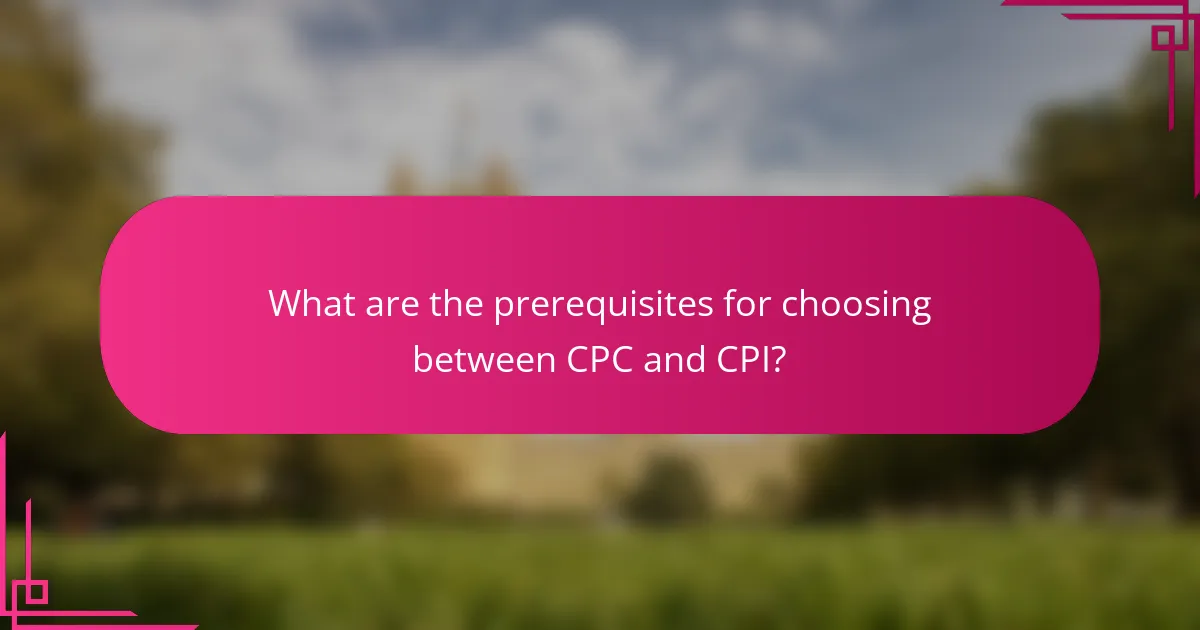
What are the prerequisites for choosing between CPC and CPI?
Choosing between Cost-Per-Click (CPC) and Cost-Per-Impression (CPI) depends on your marketing objectives and the nature of your campaign. Understanding your goals, budget, and target audience will help you determine which pricing model aligns best with your needs.
Campaign goals
Your campaign goals play a crucial role in deciding between CPC and CPI. If your primary aim is to drive traffic to your website and generate leads, CPC may be more effective as you only pay when users click on your ads. Conversely, if brand awareness and visibility are your main objectives, CPI can be advantageous since you pay for impressions, allowing your ad to reach a broader audience.
Consider the type of product or service you are promoting. For instance, e-commerce businesses often benefit from CPC, while companies launching new products might prefer CPI to maximize exposure.
Budget considerations
Budget constraints significantly influence the choice between CPC and CPI. CPC campaigns can be more cost-effective if you have a limited budget and want to ensure that your spending directly correlates with user engagement. However, if your budget allows for broader reach, CPI can provide a larger number of impressions at a potentially lower cost per view.
Evaluate your expected return on investment (ROI) for each model. For example, if you anticipate a high conversion rate from clicks, CPC may yield better results. On the other hand, if your goal is to build brand recognition over time, CPI could be the better option, even if it requires a higher upfront investment.
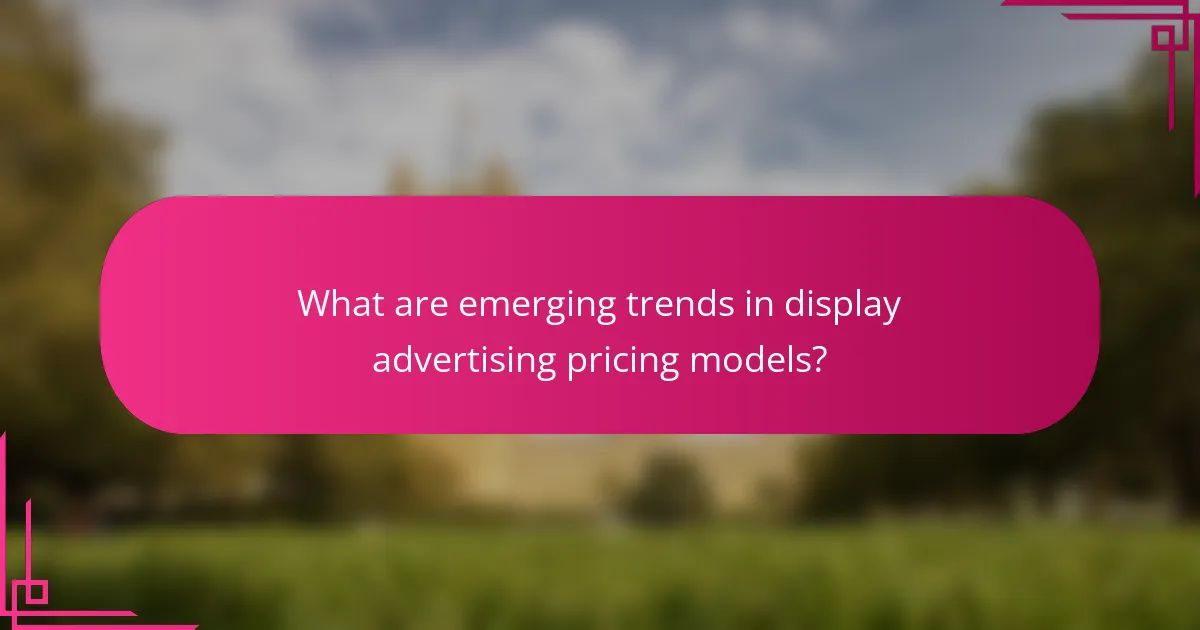
What are emerging trends in display advertising pricing models?
Emerging trends in display advertising pricing models indicate a shift towards more flexible and performance-based strategies. Advertisers are increasingly adopting hybrid models that combine Cost-Per-Click (CPC) and Cost-Per-Impression (CPM) to optimize their campaigns based on specific goals and audience engagement.
Increased Adoption of Programmatic Advertising
Programmatic advertising is becoming a dominant force in display ad pricing, allowing for real-time bidding and automated ad placements. This model enhances efficiency by targeting specific audiences and optimizing ad spend based on performance metrics. Advertisers can adjust their strategies on-the-fly, ensuring better alignment with campaign objectives.
Focus on Performance-Based Metrics
There is a growing emphasis on performance-based pricing models, which prioritize outcomes over impressions. Advertisers are increasingly looking at metrics such as click-through rates and conversion rates to determine the effectiveness of their campaigns. This shift encourages advertisers to invest in high-quality placements that drive measurable results.
Integration of Artificial Intelligence
Artificial intelligence (AI) is playing a crucial role in optimizing display advertising pricing models. AI algorithms analyze vast amounts of data to predict user behavior and adjust bids accordingly. This technology helps advertisers maximize their return on investment by targeting the right audience at the right time with the right message.
Emphasis on Transparency and Brand Safety
Advertisers are demanding greater transparency in pricing models to ensure that their budgets are spent effectively. This trend includes clear reporting on where ads are placed and how they perform. Additionally, brand safety concerns are leading to stricter regulations and standards in display advertising, ensuring that ads do not appear alongside inappropriate content.
